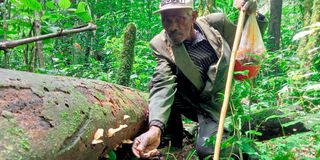Premium
Why we need indigenous forests for our genes survival

Christine, the founder, told us that she named the gallery Ardhi, because it’s about starting from the
ground — from where we are, and it strips us from the societal hierarchies of status and elitism—we’re
all at the same level from a fundamental perspective, we’re all equal, and we all have something unique
to say. Ardhi’s mission is to provide a space for that discourse to take place. Photo | Pool
What you need to know:
Protecting small patches of indigenous forest is more important than planting trees
Ancient trees fringe the manicured garden at the end of Tree Lane in Nairobi’s suburbia, Karen, a green escape from the busy city. It’s the Wednesday bird walk with the nature-lovers scanning the space with their binoculars and in a few seconds somebody states, “A chameleon.”
It’s the three-horned Jackson’s chameleon as green as the shrub it’s on to camouflage itself. But nothing escapes the sharp-eyed birders and suddenly this handsome male reptile becomes a most-photographed model. The three-horned Jackson’s chameleon also known as the Kikuyu three-horned chameleon is an East African species where only the male has three horns to protect his territory.
The June morning is chilly and everything is quiet at Entim Sidai or the beautiful forest in the Maasai language. Strolling past the gigantic fig tree revered as sacred, a cloud of winged beauties rises like confetti, fluttered wings animating the path. They are Achaea moths that have recently erupted, so tells our “insect man”, Benard Koros, who is the naturalist at City Park forest. Their caterpillars had been eating the leaves of the Croton trees in Karen and Langata.
The birders become excited sighting an African Green Pigeon in the fig tree. “It’s very beautiful but hard to see because it looks just like the leaves,” enthuses Fleur Ng’weno, Kenya’s doyenne of the bird world who in her 80s is busier than ever.
By now we’re entering the forest with the stunning Cape Chestnut (an indigenous tree) in splashes of pink bloom when a Hartlaub’s Turaco with its scarlet wingtips flies out. It’s a true forest bird and truly beautiful.
It’s tranquil inside the forest with vines and ferns filling the space under the canopy and butterflies in many colours flitting about. Many more forest birds are entered on the bird app.
Then in the shaded world of the forest - at eye-level - two round eyes stare at us. It’s an African Wood Owl on a tree branch, awoken by its acute hearing of the whispering of the enchanted birders. It’s hard not to fall in love with it and more so since they are really good at hunting mice and rats and hence are really excellent pest controllers.
Stepping out of the forest, an African Crowned Eagle is circling overhead. “Although they are rare elsewhere, they are not rare in Nairobi,” continues Ng’weno who started the weekly Wednesday bird walks from the Nairobi National Museum in 1971 – probably one of the most regular bird walks in the world. In every sizeable indigenous forest – like Oloolua, Karura and Ngong Road forests and Nairobi National Park – in Nairobi, a fast-paced city of more than five million people, there is at least a pair of Africa’s most powerful eagle.
“Protecting small patches of indigenous forest like this one that neighbours others is even more important than planting trees,” counsels Ng’weno. “An indigenous forest is more than just trees, because the forest includes fungi and microorganisms under the ground and all the wildlife that lives there. And a whole forest includes genes that we might need in future.”
That’s the important bit – genes. Since ancient times, humans have used forests for sourcing medicinal plants. Even today genes are important for medicine or a crop plant that needs to be strengthened. “It happens all the time, when crop plants are bred with their wild relatives to add resilience; and most medicines are derived from plants,” Ng’weno explains to the eager group of birders.
Stepping out of the forest onto the manicured lawn, insect man Koros is suddenly excited. He’s seen his ‘lifer’ – meaning a bird the person sees for the first time. But in his case, it’s a butterfly – Mackinnon’s Swallowtail, a rare species found in the highland forest. It’s made his day.
Did you know? Nairobi had a belt of indigenous upland dry forest between the grassland of the Maasai pastoralists and the agricultural land of the Kikuyu.
Discover nature with Nature Kenya https://naturekenya.org/ – it’s a great way to stay healthy, walk forests, breathe in fresh air and meet interesting people.
Entim Sidai is a wellness spa surrounded by the forest.
Karen has lots to explore like trendy restaurants and boutiques.
www.rupitheafricantrotter.com




